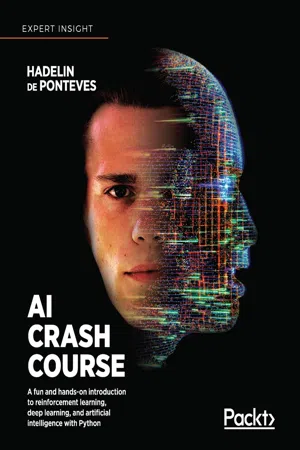
AI Crash Course
A fun and hands-on introduction to reinforcement learning, deep learning, and artificial intelligence with Python
Hadelin de Ponteves
- 360 pages
- English
- ePUB (adapté aux mobiles)
- Disponible sur iOS et Android
AI Crash Course
A fun and hands-on introduction to reinforcement learning, deep learning, and artificial intelligence with Python
Hadelin de Ponteves
À propos de ce livre
Unlock the power of artificial intelligence with top Udemy AI instructor Hadelin de Ponteves.
Key Features
- Learn from friendly, plain English explanations and practical activities
- Put ideas into action with 5 hands-on projects that show step-by-step how to build intelligent software
- Use AI to win classic video games and construct a virtual self-driving car
Book Description
Welcome to the Robot World … and start building intelligent software now!
Through his best-selling video courses, Hadelin de Ponteves has taught hundreds of thousands of people to write AI software. Now, for the first time, his hands-on, energetic approach is available as a book. Starting with the basics before easing you into more complicated formulas and notation, AI Crash Course gives you everything you need to build AI systems with reinforcement learning and deep learning. Five full working projects put the ideas into action, showing step-by-step how to build intelligent software using the best and easiest tools for AI programming, including Python, TensorFlow, Keras, and PyTorch.
AI Crash Course teaches everyone to build an AI to work in their applications. Once you've read this book, you're only limited by your imagination.
What you will learn
- Master the basics of AI without any previous experience
- Build fun projects, including a virtual-self-driving car and a robot warehouse worker
- Use AI to solve real-world business problems
- Learn how to code in Python
- Discover the 5 principles of reinforcement learning
- Create your own AI toolkit
Who this book is for
If you want to add AI to your skillset, this book is for you. It doesn't require data science or machine learning knowledge. Just maths basics (high school level).
Foire aux questions
Informations
11
AI for Business – Minimize Costs with Deep Q-Learning
Problem to solve
Building the environment
- First, we'll list all the environment parameters and variables by which the server is controlled.
- After that we'll set the essential assumptions of the problem, on which your AI will rely to provide a solution.
- Then we'll specify how you'll simulate the whole process.
- Finally, we'll explain the overall functioning of the server, and how the AI plays its role.
Parameters and variables of the server environment
- The average atmospheric temperature for each month.
- The optimal temperature range of the server, which we'll set as .

- The minimum temperature, below which the server fails to operate, which we'll set as .

- The maximum temperature, above which the server fails to operate, which we'll set as .

- The minimum number of users in the server, which we'll set as 10.
- The maximum number of users in the server, which we'll set as 100.
- The maximum change of users in the server per minute, which we'll set as 5; so every minute, the server can only have a change of 5 extra users or 5 fewer users at most.
- The minimum rate of data transmission in the server, which we'll set as 20.
- The maximum rate of data transmission in the server, which we'll set as 300.
- The maximum change of the rate of data transmission per minute, which we'll set as 10; so every minute, the rate of data transmission can only change by a maximum value of 10 in either direction.
- The temperature of the server at a given minute.
- The number of users connected to the server at a given minute.
- The rate of data transmission at a given minute.
- The energy spent by the AI onto the server (to cool it down or heat it up) at a given minute.
- The energy that would be spent by the server's integrated cooling system to automatically bring the server's temperature back to the optimal range, whenever the server's temperature goes outside this optimal range. This is to keep...